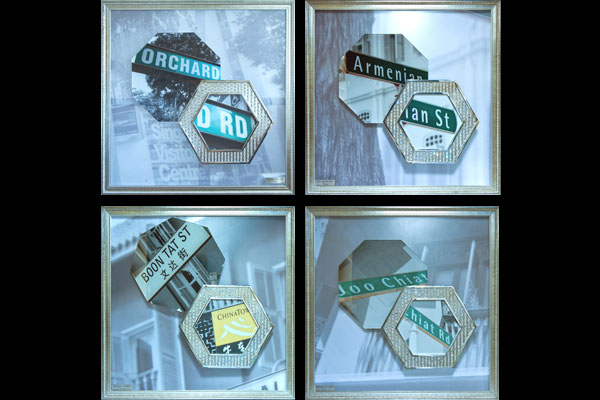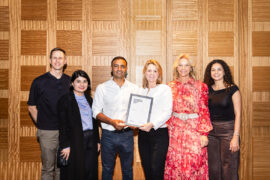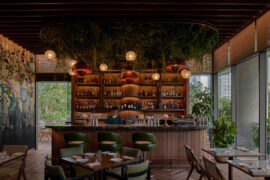Art courses through the veins of Isabelle Miaja and her interior design firm, MIAJA Design Group, writes Iliyas Ong.

July 2nd, 2014
Step into the Singapore headquarters of MIAJA Design Group and you’ll be greeted by bric-a-brac: a rhinoceros sculpture here, a three-dimensional artwork of street signs there, and other curious art objects in between. They present a keen insight into the world of Isabelle Miaja, founder of the interior design firm whose hotels, resorts and residences come well-stocked with fine arts pieces – often those created by Miaja herself. Call it art for design’s sake.
So central is art to Miaja’s design philosophy that she admits her practice often begins each project by curating artwork. “We start with the art, and that flows into the design,” she explains. “Art has a very intimate relationship with place and people, so we often pick pieces that reflect the place we’re working on.”

Prism Collection by MIAJA in collaboration with Christian Konold, for Sofitel So Singapore
This means researching a region or city’s indigenous cultural heritage to find gems of inspiration for her art. For example, in Sofitel So Singapore, one of MIAJA’s more recent projects, the designer worked on a photo-series for the hotel, some in collaboration with other creatives.

Eight by Six Collection by MIAJA for Sofitel So Singapore
In one collection for Sofitel So, entitled “Eight by Six”, images of Singapore’s rapidly changing urban fabric merge with street signs, hence “weaving in the idea of constant transformation that the city is known for,” she says. “I want the space to ‘belong’ to its country, city, neighbourhood and users.”
But such a process can prove challenging at times, Miaja confesses, especially when a locale has no easily discernible “culture of spaces”. This is most pronounced in the Middle East, where she has worked on several hotels, including Dubai’s Desert Palm Resort. In that project, rather than suffuse the space with visual art, Miaja used the “rhythm and colour of sand dunes” to inspire the undulating fixtures and furnishings, and tone-on-tone colour palette that runs throughout the resort.
“It’s a much deeper and less obvious journey to create something from histories and geographies. Sometimes, you look at the environment of a space and everything is about curves, softness and movement rather than, say, squares. You can then take those native elements and weave a story,” she notes.
Miaja’s bespoke approach to interior design – she also insists on purpose-building most of the furniture she uses – allows a resort or hotel, no matter how sprawling, to look and feel more like boutique lodging. Sofitel So’s 137 rooms, for instance, are individually dressed up in styles that fuse 19th Century French opulence with modern Singaporean architecture, two seemingly disparate languages. But as Miaja surmises, “That’s the thing about interior design: you can create opposites, and they can attract.”
All this must come naturally for Miaja, whose childhood in Paris, academic background in languages and a mixed Spanish-French parentage formed the basis for her eclectic taste. Familiar to creative pursuits since a young age (her father was a jewellery designer), at 22 she enrolled in the School of Applied Arts in Los Angeles and thereafter began working for several interior design firms in the US.
In 1995, she moved to Singapore to set up MIAJA, then known as Isabelle Miaja and Associates. And she never looked back. Today, MIAJA’s reach extends to Dubai and Manila, with a fourth office slated to open in Myanmar in September this year.
“I felt that Singapore was going to be a great place to start a business,” she recalls. “And there was everything yet to be built! In a country like the US, the market was much more mature. It was a great thing for me not only to offer what I knew about design but also to evolve and to be inspired by all the Asian cultures. So I actually grew the company alongside the growth of Singapore, where the design industry has developed incredibly.”
MIAJA Design Group
miajadesigngroup.com
INDESIGN is on instagram
Follow @indesignlive
A searchable and comprehensive guide for specifying leading products and their suppliers
Keep up to date with the latest and greatest from our industry BFF's!

London-based design duo Raw Edges have joined forces with Established & Sons and Tongue & Groove to introduce Wall to Wall – a hand-stained, “living collection” that transforms parquet flooring into a canvas of colour, pattern, and possibility.

For Aidan Mawhinney, the secret ingredient to Living Edge’s success “comes down to people, product and place.” As the brand celebrates a significant 25-year milestone, it’s that commitment to authentic, sustainable design – and the people behind it all – that continues to anchor its legacy.
The internet never sleeps! Here's the stuff you might have missed

GEYER VALMONT is launching an innovation hub designed to improve existing interior design capability through enhanced ways of working and industry-leading technology products.

The winners of two major Powerhouse design initiatives – the Holdmark Innovation Award and the Carl Nielsen Design Accelerator – have been announced with the launch of Sydney Design Week 2025.

In this comment piece by Dr Matthias Irger – Head of Sustainability at COX Architecture – he argues for an approach to design that prioritises retrofitting, renovation and reuse.

Grounded by the rich warmth of American white oak, The Standard’s newly opened restaurant, Kaya, redefines the classic dining convention through a tasteful fusion of biophilic design, mid-century modern sensibility and elevated whimsy.